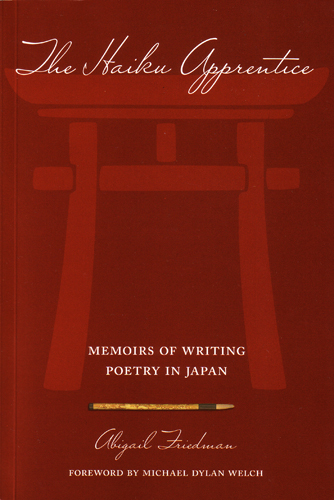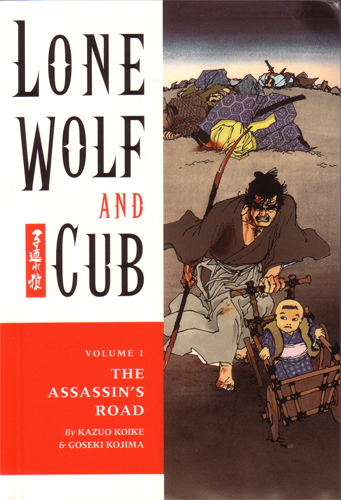
The Haiku Apprentice is a memoir of Abigail Friedman, a remarkable woman who lived as a diplomat in Japan for two years. In her book, the journey of a woman in Japan writing, discovering and exploring the ancient Japanese art of Haiku poetry is laid out in a style accessible to any reader. I highly recommend this book for anyone with even a passing interest in haiku or Japan.
I was immediately drawn to this book simply by the title. The Haiku Apprentice conjures up the image of a remote sanctuary; the student living side by side with the teacher, exploring the depth of their self identity and their passion for their art. And though this romantic image is somewhat different when finally compared to Abigail Friedman’s honestly scripted experience, I think that parallels can be drawn between the image and the reality.
One thing that I appreciate about this book was that Friedman could have chosen to write a fascinating memoir simply about her experience as an expatriate and a diplomat in Japan. Her life story seems to be very unique, full of travel and adventure and she could have chosen to write about her experience from any number of fascinating aspects. However, she chose to tell a story via her very specific experience with haiku. By doing so, she brings haiku to the reader in a way that doesn’t feel like a textbook or a lecture on the intricacies of an archaic art form. In fact Friedman lets the reader know that Haiku is an art form very much alive in contemporary Japan.
Friedman meets a member of a haiku group who invites her to join the group to see for herself what it is like. Despite her uncertainty Abigail’s adventurous spirit guides her. Traveling to a part of the country she has never been to before she meets Momoko, the group’s resident haiku master, and discovers that there is more to this coveted art form then a 5-7-5 syllabic structure. She starts to see haiku differently than before, and her understanding of this art form takes shape. As she describes her struggles learning to find the perfect kigo, or seasonal word, to make her haiku just right, the reader passes through the Japanese landscape along with her.
The book is organized in what seems to be a series of separate, but related, anecdotes or journal entries. I enjoyed this style because it gave me a sense of the reality from which the book came, that these were real memories from a real person. And in that sense, it felt as though I was being brought closer to the writer.
The haiku that are strewn throughout the book are written by a variety of people, from the old, revered Japanese masters such as Basho and Issa to Mrs. Friedman herself; she even includes a wonderful anecdote about a caption she read on the side of the bus. She writes “Well, I knew it was an advertising jingle, but still, wasn’t it an advertising jingle haiku?” As she encounters more haiku and begins to learn more about it, Friedman also gains a deeper understanding of Japanese culture
It is intriguing to read how Abigail’s first impression of haiku is challenged as she uncovers more about this once elusive poetic style. Her story is charming and relatable, with tales about her work and life with her family mixed into her account of private meetings with her haiku and calligraphy teachers. She tells us about her experiences; her joys and frustrations while living in the foreign land and her personal relationship with haiku seems to thread through all aspects of her life, grounding her experience in Japan.
Anyone can appreciate this book, having traveled to Japan or not. So, order a copy today, and then be the first one in the neighborhood to start your own haiku group!

 Simply put, I have never read anything quite like this. The title and covers imply some kind of horror story, but Death Note is much more challenging than simple horror. Without revealing too much, (going in knowing very little has made the experience that much better), Death Note is more of a large scale moral battle. We learn early on that the Death Note itself is a notebook, in which it's owner can write the name of any living person and they will die (time and means of death are up to the owner). These notebooks are usually held by the gods of death, but occasionally they can fall into human hands, as is the case where our story opens. What follows is sometimes shocking, sometimes frustrating and always keeps you wanting to read more. What would you do if you could eliminate any person you wanted to? How could you possibly be caught? Brains and wits are required when using the Death Note...especially when all the world is looking for it's owner...
Simply put, I have never read anything quite like this. The title and covers imply some kind of horror story, but Death Note is much more challenging than simple horror. Without revealing too much, (going in knowing very little has made the experience that much better), Death Note is more of a large scale moral battle. We learn early on that the Death Note itself is a notebook, in which it's owner can write the name of any living person and they will die (time and means of death are up to the owner). These notebooks are usually held by the gods of death, but occasionally they can fall into human hands, as is the case where our story opens. What follows is sometimes shocking, sometimes frustrating and always keeps you wanting to read more. What would you do if you could eliminate any person you wanted to? How could you possibly be caught? Brains and wits are required when using the Death Note...especially when all the world is looking for it's owner...












